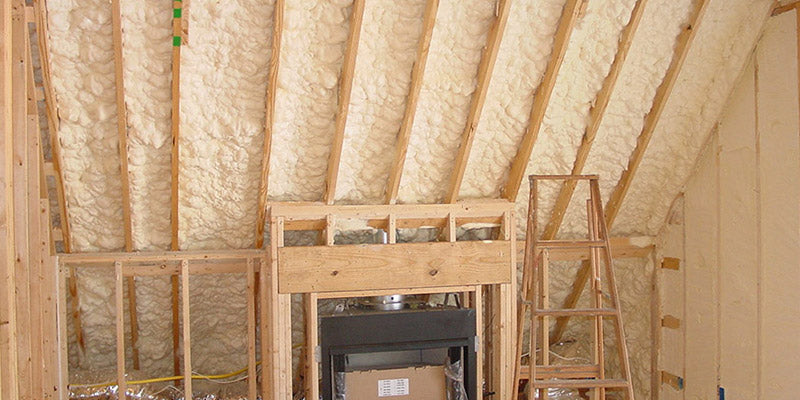Choosing the proper insulation for your home or building is crucial, and the debate between closed-cell vs open cell foam is a common topic among builders and homeowners. This article delves deep into the differences between closed cell spray foam and cell, covering aspects like R-value, cost, soundproofing, and specific use cases like insulation in metal buildings.
Understanding Foam Insulation
Foam insulation is famous for its excellent thermal resistance and airtight sealing. But when it comes to closed cell vs open cell single foam insulation, understanding their distinct properties and applications is critical to making an informed decision.
Closed Cell vs Open Cell Foam R Value
-
Closed Cell Foam R-Value
Closed cell foam typically has a higher R-value per inch than open cell foam, ranging from 6 to 7 per inch. This higher R-value means better thermal resistance, making it more effective in preventing heat transfer.
-
Open Cell Foam R-Value
Open cell foam, while having a lower R-value of around 3.5 to 4 per inch, still provides decent insulation and is often sufficient for many applications. Its lower density makes it more flexible in specific installation scenarios.
Closed Cell vs. Open Cell Foam Pros and Cons
| Closed Cell Foam | Open Cell Foam |
|---|---|
|
Pros:
|
Pros:
|
|
Cons:
|
Cons:
|
Closed-Cell vs Open-Cell Foam Cost
When comparing closed-cell vs open-cell foam cost, closed-cell foam is typically more expensive due to its higher density and R-value. However, the choice should also consider long-term energy savings and the specific requirements of the building.
Read More: How Much Does It Cost to Spray Foam a 2,000 Square Foot House?
Applications in Insulation
Closed Cell vs Open Cell Foam in Metal Buildings
Closed cell foam is often preferred in metal buildings due to its moisture resistance and higher R-value, providing better condensation control. Open cell foam, while less commonly used in metal buildings, can be a cost-effective solution for less demanding applications.
Open Cell Foam Insulation Problems
While open cell foam is versatile, it's not without issues. Its tendency to absorb moisture can lead to problems in humid environments and may require a vapor barrier in specific installations.
Soundproofing Capabilities
Closed Cell vs Open Cell Foam Soundproofing
Open cell foam is generally more effective for soundproofing due to its density and flexibility, which better absorbs sound waves. Closed cell foam, while providing some soundproofing, is primarily valued for its thermal insulation properties.
Installation Considerations
The installation of both closed cell and open cell foam requires professional expertise. Closed cell foam's rigidity demands precise application, while open cell foam's flexibility requires careful handling to ensure even coverage.
Environmental Impact
The ecological footprint of both types of foam insulation is a consideration for environmentally conscious builders. Closed cell foams often use high-global-warming-potential gases as blowing agents, whereas open cell foams typically have a lower environmental impact.
Longevity and Durability
In terms of durability, closed cell foam lasts longer and is less susceptible to damage from moisture and pests. Open cell foam, while durable, may require more maintenance in damp conditions.
Energy Efficiency Comparisons
How They Affect Heating and Cooling Costs
Energy efficiency is a critical aspect of insulation. With its higher R-value, closed cell foam can lead to more significant energy savings in heating and cooling. It creates a more airtight seal, reducing air leaks. Open cell foam, while less efficient per inch, can still provide substantial energy savings, especially in climates where extreme insulation isn't necessary.
Health and Safety Aspects
Indoor Air Quality Concerns
Both closed cell and open cell foams have implications for indoor air quality. The higher density of closed cell foam can reduce air infiltration, potentially improving indoor air quality by limiting outdoor pollutants. However, ensuring proper ventilation is essential to avoid stagnant indoor air. Open cell foam, being more breathable, can help regulate indoor air moisture levels but may be less effective in filtering pollutants.
Read More: Is Foam Insulation Safe for Health?
Fire Resistance and Safety
Evaluating Their Fire Performance
When it comes to fire safety, both types of foam insulation have different characteristics. Closed cell foam often contains fire retardants, giving it a slight edge in fire resistance. However, neither type should be considered a fire-stop solution, and additional fire-resistant materials may be necessary depending on building codes and personal safety preferences.
Retrofitting Existing Homes
Ease of Installation in Renovation Projects
For retrofitting existing homes, the choice between closed cell and open cell foam can depend on the nature of the project. Open cell foam, being more flexible and easier to install in irregular spaces, might be preferable in renovations where preserving existing structures is crucial. With its higher R-value, closed cell foam is more suitable for projects where maximizing insulation in limited space is the priority.
Soundproofing in Detail
Comparing Their Effectiveness in Noise Reduction
For homeowners concerned about noise, open cell foam is the clear winner. Its softer, more open structure is better at absorbing sound, making it ideal for use in walls and ceilings for sound dampening. Closed cell foam, while providing some soundproofing, is more rigid and less effective at absorbing good vibrations.
Moisture Control and Mold Prevention
How They Stand Up to Humidity and Water
In terms of moisture control, closed cell foam offers superior protection. Its dense structure acts as a barrier to both air and moisture, reducing the risk of mold and water damage. This makes it especially useful in basements, bathrooms, and kitchens. Open cell foam, while breathable, can absorb moisture, making it less ideal in damp environments unless adequately protected with vapor barriers.
Learn more about how spray foam reacts to water:
Ecological Considerations
Sustainability and Environmental Impact
Sustainability is an increasing concern in construction materials. Open cell foam is generally considered more environmentally friendly due to its lower impact blowing agents and manufacturing process. However, the higher energy efficiency of closed cell foam can offset its environmental impact over the lifespan of the building.
Financial Implications
Long-Term Savings vs. Upfront Costs
While closed cell foam generally has higher upfront costs due to its density and manufacturing process, it can offer more significant long-term savings through reduced energy bills. Open cell foam is more budget-friendly initially but might provide a different energy efficiency over time.
Understanding Installation Processes

Best Practices for Effective Insulation
Proper installation is crucial for both closed cell and open cell foam. For closed cell foam, attention must be paid to the thickness of the application to ensure maximum effectiveness. Open cell foam requires careful installation to avoid overspray and uneven coverage. In both cases, professional installation is recommended for optimal performance and safety.
Climate Considerations in Insulation Choice
Adapting Insulation to Environmental Needs
Climate plays a significant role in choosing between closed and open cell foam. In colder climates, closed cell foam's higher R-value and moisture resistance make it a more suitable option, especially in areas prone to heavy rain or snow. In milder climates, open cell foam's cost-effectiveness and soundproofing qualities might be more appealing.
Life Cycle and Durability
Assessing Long-Term Performance
The lifespan of your insulation is an important consideration. Closed cell foam is known for its durability and long life cycle, often lasting the life of the building without significant deterioration. Open cell foam, while durable, may require more maintenance and checks for moisture absorption over time.
Customization and Flexibility
Tailoring Insulation to Specific Projects
Both foam types offer different customization levels and flexibility for specific projects. Open cell foam can be easily cut and shaped to fit irregular spaces and complex geometries, making it ideal for custom projects. Due to its rigidity, closed cell foam is less versatile in this regard but provides unmatched insulation in standard applications.
Understanding Building Codes and Regulations
Compliance with Safety and Energy Standards
Compliance with local building codes and energy regulations is crucial in your insulation choice. Closed cell foam often meets stricter codes due to its high R-value and moisture resistance. However, in some cases, open cell foam can be sufficient, especially when combined with other energy-saving features.
Addressing Common Misconceptions
Dispelling Myths About Foam Insulation
Several things need to be clarified about both types of foam insulation. One common myth is that all foam insulation is the same, ignoring the distinct structure and performance differences between open and closed cell foams. Another is the belief that foam insulation always leads to mold issues, which is invalid if properly installed and maintained.
Innovations and Future Trends in Foam Insulation
Staying Ahead with Modern Insulation Solutions
The insulation industry is continually evolving, with new technologies and materials emerging. Eco-friendly options, improved fire-resistant formulations, and advanced installation techniques are shaping the future of foam insulation. Staying informed about these trends can help you make a more future-proof choice for your insulation needs.
Conclusion
Ultimately, the decision between closed and open cell foam depends on a balance of factors, including thermal performance, moisture resistance, soundproofing, cost, and environmental impact. Both have their place in the construction industry, and the right choice varies based on individual project requirements and preferences. By understanding the unique properties and applications of each, homeowners and builders can make informed decisions that lead to comfortable, energy-efficient, and sustainable living spaces.
FAQs on Open Cell vs Closed Cell Foam Insulation
Which is Better: Open Cell or Closed Cell Foam?
The choice between open and closed cell foam depends on specific needs and applications. Closed cell foam is better for areas requiring higher R-value insulation and moisture resistance and where space is limited. Open cell foam is preferred for soundproofing, more affordable insulation solutions, and where flexibility and breathability are desired. The best option varies based on the climate, budget, and specific application requirements.
What Are the Disadvantages of Closed Cell Spray Foam?
The disadvantages of closed-cell spray foam include the following:
- Higher Cost: It is generally more expensive than open cell foam due to its density and manufacturing process.
- Rigidity: Its rigid nature can challenge installation in tight or irregular spaces.
- Environmental Concerns: Some closed-cell foams use high-global-warming-potential blowing agents, raising environmental concerns.
- Over-Insulation Risk: If not correctly installed, it can lead to over-insulation, trapping moisture, and potentially leading to mold issues.
Why Use Closed Cell Spray Foam?
Closed-cell spray foam is used for its excellent properties, including:
- Higher R-value: Offers superior thermal insulation per inch of thickness.
- Moisture Resistance: A moisture barrier prevents water and dampness penetration.
- Structural Strength: Adds rigidity and strength to the building structure.
- Air Sealing: Provides an excellent air barrier, reducing energy costs and improving indoor air quality.
Is Closed Cell Foam More Expensive Than Open Cell Foam?
Yes, closed cell foam is generally more expensive than open cell foam. This is due to its higher density, more complex manufacturing process, and the materials used. The increased cost is often justified by its higher R-value, moisture resistance, and durability, making it a cost-effective solution in the long run for specific applications.




